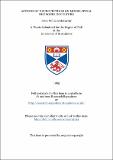Files in this item
Actions of neuropeptides on mouse spinal neurones in culture
Item metadata
| dc.contributor.advisor | Cottrell, Glen A. | |
| dc.contributor.author | McCarthy, Peter William | |
| dc.coverage.spatial | [ca 300] p. | en_US |
| dc.date.accessioned | 2018-06-29T10:56:44Z | |
| dc.date.available | 2018-06-29T10:56:44Z | |
| dc.date.issued | 1985 | |
| dc.identifier.uri | https://hdl.handle.net/10023/14744 | |
| dc.description.abstract | 1] Spinal cords from mouse embryos were successfully prepared and maintained in primary dissociated cell culture, for periods in excess of 10 weeks. 2] Stable intracellular recordings were made from spinal neurones which had been sustained in these cultures. 3] Experiments were made on these spinal neurones using various amino acids and peptides. Solutions of these compounds were discretely applied by pressure ejection. 4] L-Glutamate, GABA and glycine evoked responses which appeared the same as those documented previously. 5] Ethylene-diamine did not evoke a response from the spinal neurones tested. 6] Only a small percentage of the spinal neurones responded to met5- and leu5 - enkephalin, FMRFamide, neurotensin and glycyl L-glutamine. Supplementing the cultures with tissue from other organs did not increase the percentage of spinal neurones which were capable of responding to peptide. 7] Met5 -enkephalin and leu5 -enkephalin each evoked responses from the spinal neurones. 8] The enkephalin-evoked depolarizations accompanied by an increased input resistance were apparently voltage dependent. These responses were abolished at potentials more negative than -90mV and did not invert under normal recording conditions. 9] The enkephalin-evoked depolarizations associated with a decreased input resistance had extrapolated inversion potentials of -20mV. No voltage dependence was seen. 10] Enkephalins also evoked responses which had an inversion potential close to the resting membrane potential. These were accompanied by a decreased input resistance and were not desensitized by prolonged application of peptide. 11] None of these responses showed obvious desensitization with prolonged application, however, they were all attenuated by naloxone. 12] Met5 -enkephalin was apparently more potent than leu5 -enkephalin on a small number of neurones. Furthermore, met5 -enkephalin application, during the weaker response from those neurones to leu5 -enkephalin, evoked a attenuated response. 13] FMRFamide evoked two responses from these spinal neurones. These responses were seen separately and mixed. In the latter case they were referred to as biphasic responses. 14] The depolarizing response to FMRFamide was accompanied by an increase in input resistance. Potassium had some involvement in these responses. 15] The FMRFamide responses which were accompanied by a decreased input resistance showed a great variety of inversion potentials between neurones. These actions were dependent upon sodium and chloride ions. 16] Enkephalin and FMRFamide, when applied separately to the same spinal neurone, did not evoke the same response. 17] Responses evoked by neurotensin were hyperpolarizations associated with a decreased input resistance. These responses were dependent upon potassium and independent of chloride ions. 18] Glycyl L-glutamine evoked two types of hyperpolarizing response from the spinal neurones. These could appear separately or combined. 19] The faster responses to glycyl L-glutamine were apparently dependent on potassium ions. 20] The slower responses to glycyl L-glutamine were apparently insensitive to changes in extracellular potassium or chloride. However, these responses were sensitive to intracellular injection of chloride ions. 21] At concentrations of peptide which evoked a response from other spinal neurones, none of the peptides produced any measurable modulation of amino acid-evoked responses. | en_US |
| dc.language.iso | en | en_US |
| dc.publisher | University of St Andrews | |
| dc.subject.lcc | QP374.M3 | |
| dc.subject.lcsh | Spinal cord | en |
| dc.title | Actions of neuropeptides on mouse spinal neurones in culture | en_US |
| dc.type | Thesis | en_US |
| dc.contributor.sponsor | Biotechnology and Biological Sciences Research Council (BBSRC) | en_US |
| dc.contributor.sponsor | Medical Research Scotland (MRS) | en_US |
| dc.type.qualificationlevel | Doctoral | en_US |
| dc.type.qualificationname | PhD Doctor of Philosophy | en_US |
| dc.publisher.institution | The University of St Andrews | en_US |
This item appears in the following Collection(s)
Items in the St Andrews Research Repository are protected by copyright, with all rights reserved, unless otherwise indicated.

